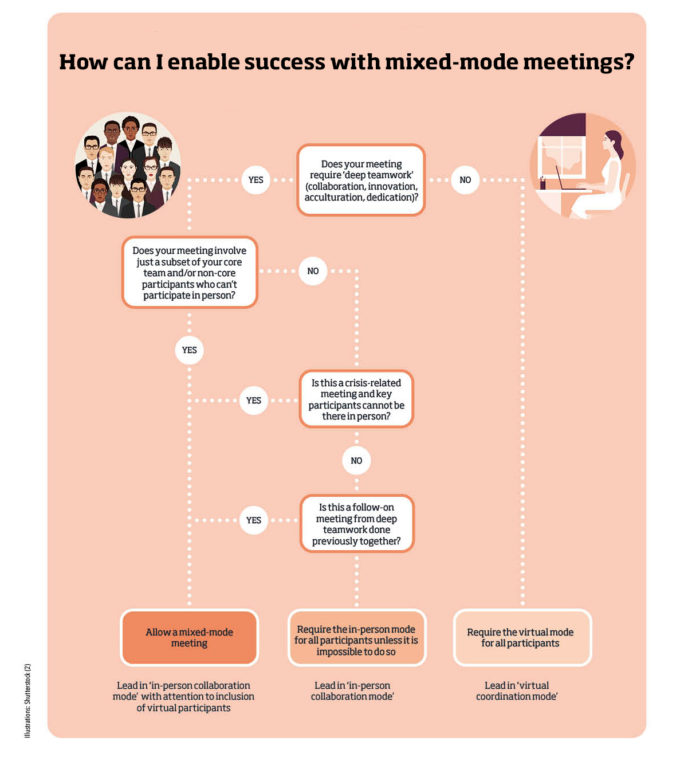
How to tame the bully on executive boards
From animal instincts to boardroom battles, the effects of bullying at the top of a company can damage profitability. Here’s how to make sure that doesn’t happen....

by Robert Hooijberg, Michael D. Watkins Published 17 September 2021 in Human Resources • 2 min read
Much of the conversation about hybrid work focuses on striking the right balance between the in-person and virtual modes. And we, too, have begun to explore the differences in how leaders need to support teamwork in the in-person and virtual modes. However, it’s increasingly clear that there is a third option – mixed-mode meetings – that presents additional challenges.
By mixed-mode, we mean meetings in which some participants are together physically while others are virtual. How should leaders balance the potential benefits of having some people present in person against the potential costs of diminished inclusion, connection, and influence for the virtual team members?
We started with the principle that mixed-mode meetings should happen only when they create concrete business value, and when it’s really not possible for the team to be together fully.
Here is our guide to how to decide whether and when to allow mixed mode meetings. This chart will help you decide when to schedule a meeting in person, when a Zoom meeting will suffice, and how to help people collaborate in hybrid gatherings.


Professor of Organizational Behaviour at IMD
Robert Hooijberg is Professor of Organizational Behavior at IMD. His areas of special interest are leadership, negotiations, team building, digital transformation, and organizational culture. Before joining IMD in September 2000, Professor Hooijberg taught at Rutgers University in their MBA and Executive MBA programs in New Jersey, Singapore, and Beijing. He is Program Director of the Breakthrough Program for Senior Executives and the Negotiating for Value Creation course.

Professor of Leadership and Organizational Change at IMD
Michael D Watkins is Professor of Leadership and Organizational Change at IMD, confounder of Genesis Advisers, and author of The First 90 Days, Master Your Next Move, Predictable Surprises, and 12 other books on leadership and negotiation. His new book, The Six Disciplines of Strategic Thinking, explores how executives can learn to think strategically and lead their organizations into the future. A Thinkers 50-ranked management influencer and recognized expert in his field, his work features in HBR Guides and HBR’s 10 Must Reads on leadership, teams, strategic initiatives, and new managers. He taught at Harvard, where he gained his PhD in decision sciences, and INSEAD before joining IMD, where he directs The First 90 Days and Transition to Business Leadership programs.

9 November 2023 • by Lars Häggström in Human Resources
From animal instincts to boardroom battles, the effects of bullying at the top of a company can damage profitability. Here’s how to make sure that doesn’t happen....

27 October 2023 • by Ginka Toegel in Human Resources
It’s time to debunk outdated myths around women lacking confidence and not asking for pay rises and focus on the real problem: societal misperceptions. ...

19 October 2023 in Human Resources
This three-pronged approach, inspired by some of India’s most successful female entrepreneurs, can help compensate for government failure on a global level when it comes to mental health....

9 October 2023 • by Natalia Olynec, Lars Häggström in Human Resources
With a growing number of employees holding their organizations to account over sustainability commitments, the onus is on HR departments to explain a firm’s purpose and impact if they are to attract...
Explore first person business intelligence from top minds curated for a global executive audience